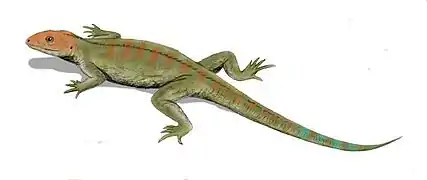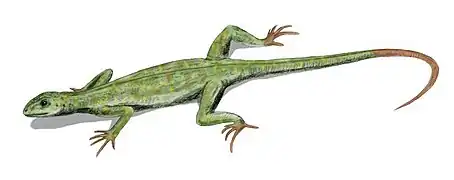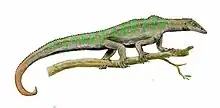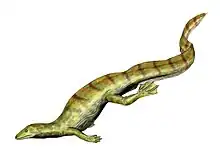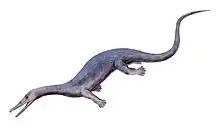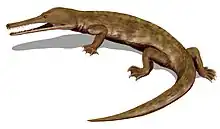| Rhabdopelix Temporal range: Late Triassic, | |
|---|---|
| Scientific classification | |
| Domain: | Eukaryota |
| Kingdom: | Animalia |
| Phylum: | Chordata |
| Class: | Reptilia |
| Family: | †Kuehneosauridae |
| Genus: | †Rhabdopelix Cope, 1870[1] |
| Type species | |
| †Rhabdopelix longispinis Cope, 1866 | |
| Synonyms | |
| |
Rhabdopelix (meaning "rod pelvis") is a dubious genus of possible kuehneosaurid reptile, from the Late Triassic-age Lockatong Formation of Pennsylvania, United States. Based on partial, possibly chimeric remains,[2] it was described by American naturalist and paleontologist Edward Drinker Cope as an early pterosaur.[3] It held this status until the 1960s, when Ned Colbert reevaluated it for his description of Icarosaurus. He noted that the bones came from a block with the remains of other animals, and that Cope had misinterpreted some of the remains; for example, the rod-like "pubic bones" that had given it its name were actually much more like the bony structures used by Icarosaurus and related animals to glide. Additionally, he couldn't relocate the fossils, which are assumed to be lost. He recommended considering Rhabdopelix a dubious name.[2] Peter Wellnhofer retained it as a pterosaur of unknown affinities in his 1978 review,[4] but rejected this by 1991.[5]
The holotype is likely a chimera consisting of Tanytrachelos, Icarosaurus, or fish fossils.[6]
See also
References
- ↑ As noted by Colbert (1966), this name was published in the 1870 portion of a multi-year publication; references to 1899 are due to a typographical error in Wellnhofer (1991)
- 1 2 Colbert, Edwin H. (1966). "A gliding reptile from the Triassic of New Jersey" (PDF). American Museum Novitates (3282): 1–23. Retrieved 2007-08-01.
- ↑ Cope, Edward Drinker (1869–1870). "Synopsis of the extinct Batrachia, Reptilia and Aves of North America". Transactions of the American Philosophical Society Philadelphia. 14 (1): 105–252 (1870). doi:10.2307/1005355. hdl:2027/nyp.33433090912423. JSTOR 1005355.
- ↑ Wellnhofer, Peter (1978). Pterosauria. Handbuch der Paläoherpetologie 19 (in German). Stuttgart: Fischer. p. 66. ISBN 978-3-437-30269-5.
- ↑ Wellnhofer, Peter (1996) [1991]. The Illustrated Encyclopedia of Pterosaurs. New York: Barnes and Noble Books. p. 58. ISBN 978-0-7607-0154-6.
- ↑ Pritchard, Adam C.; Turner, Alan H.; Nesbitt, Sterling J.; Irmis, Randall B.; Smith, Nathan D. (2015-03-04). "Late Triassic tanystropheids (Reptilia, Archosauromorpha) from northern New Mexico (Petrified Forest Member, Chinle Formation) and the biogeography, functional morphology, and evolution of Tanystropheidae". Journal of Vertebrate Paleontology. 35 (2: e911186): e911186. Bibcode:2015JVPal..35E1186P. doi:10.1080/02724634.2014.911186. ISSN 0272-4634. JSTOR 24524166. S2CID 130089407.

